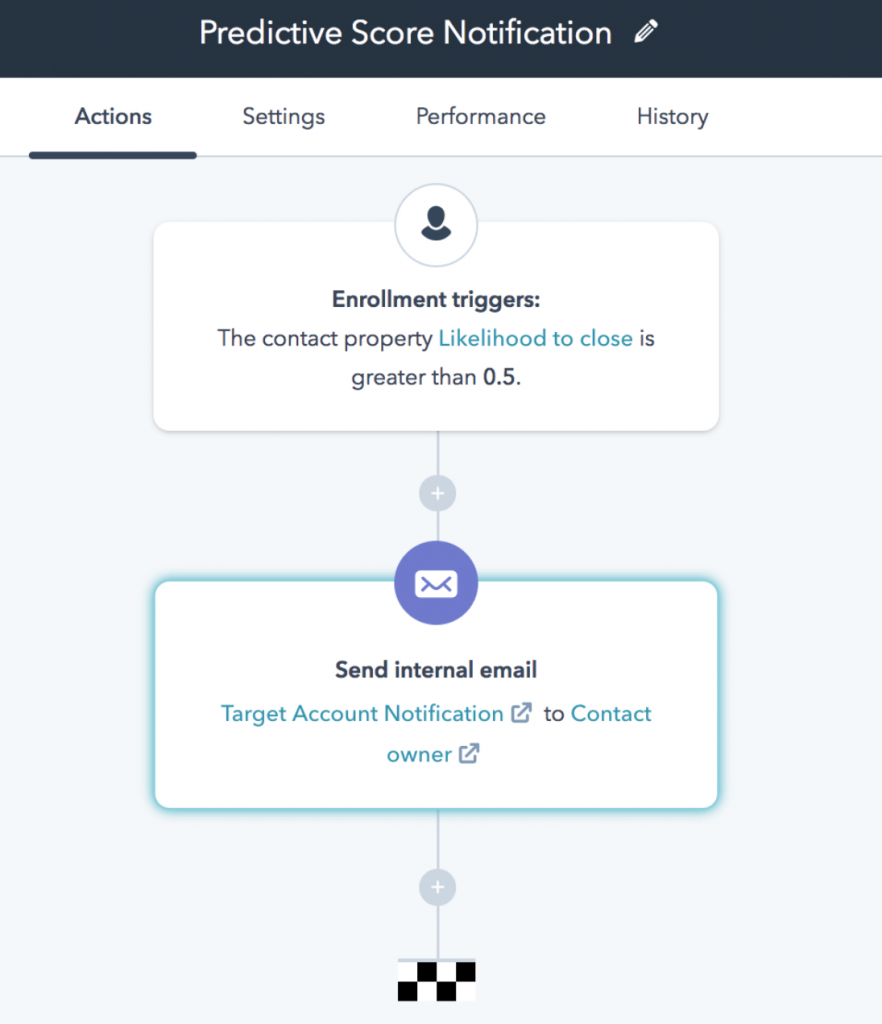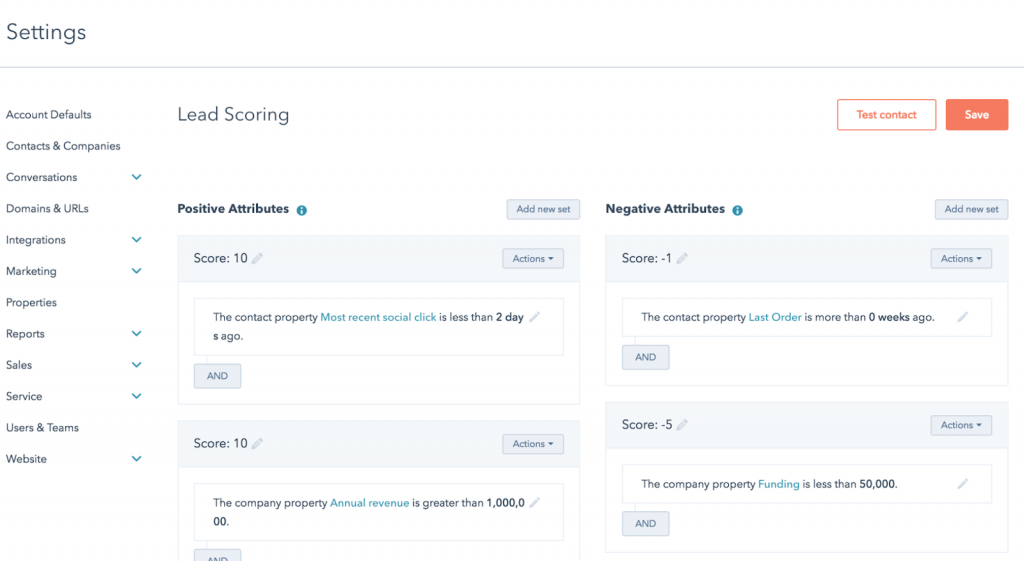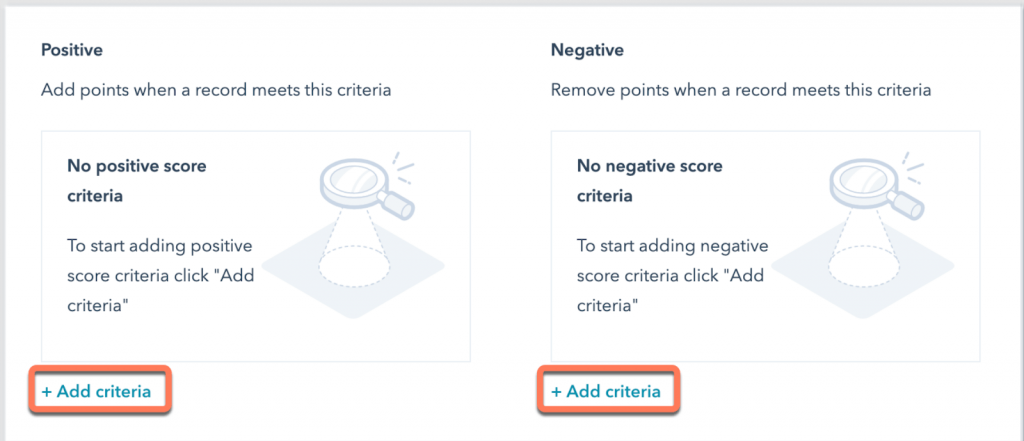Lead scoring is a secret weapon for sales teams to identify their hottest prospects and convert them into paying customers. Businesses can prioritize their efforts and close more deals faster by assigning scores to leads based on their engagement.
With a user-friendly interface and customizable criteria, HubSpot’s lead scoring SaaS solution makes it easy to set up and manage your lead scoring system. In addition, integration with other tools allows you to target and personalize your approach to each lead. In this article, we’ll delve into the process and find out how to streamline your sales operations and increase conversions.
Contents:
1. What is HubSpot lead scoring?
2. Why use HubSpot score for your leads?
- Manual lead scoring
- Predictive lead scoring
- Logistic regression lead scoring
- Lead scoring based on fit and activity
4. What are Hubspot score attributes?
5. How to set up HubSpot lead scoring?
6. Tips for effective HubSpot lead scoring
What is HubSpot lead scoring?
HubSpot lead scoring is a feature that allows businesses to assign scores to leads based on their engagement with the company’s content and interactions with the sales team. These scores rank leads and determine which ones are most likely to convert into customers.
Lead qualification is implemented in HubSpot by first setting up a system where certain criteria are defined for assigning scores to leads. HubSpot score assigns a numerical value to each of your leads based on these criteria.
The process of lead scoring is tightly related to the terms MQL, SQL, and PQL used in sales and marketing to evaluate the potential value of a lead or prospect.
MQL stands for Marketing Qualified Lead. This term describes a lead that has been identified by the marketing team as having a higher potential for becoming a customer than other leads but isn’t ready to make a purchase straight away. MQLs are leads that have engaged with your brand through their submission of contact information, opting into a program, adding e-commerce items to their carts, downloading materials, or repeatedly visiting your website. These leads are considered more promising than others as they’ve shown a level of curiosity and consideration for your brand and are more likely to engage in a sales conversation compared to a typical lead.
SQL stands for Sales Qualified Lead. This term describes a lead vetted by the marketing and sales team and considered ready for further engagement. An SQL is a prospect who has demonstrated a desire to purchase a company’s products and has met the organization’s criteria for determining if a buyer is a good fit. This label is given to a lead who has progressed beyond the engagement stage and is ready to be converted into a paying customer.
PQL stands for Product Qualified Lead. This term is used to describe a lead that has shown interest in a specific product or service offered by a company (freemium or a free trial).

Lead scoring is an essential part of B2B lead generation, especially if you are planning to sell to new groups of customers, offer new products or services, or try out new regions. Additionally, it can help to focus on increasing current customers’ sales rather than acquiring new ones.
Why use HubSpot score for your leads?
According to Gartner, 80% of your company’s future revenue will come from just 20% of your existing customers. Therefore, your sales and marketing teams should focus on opportunities at the bottom instead of driving leads at the top.
The following are some main benefits of using scoring in your working processes:
- Prioritization and improving efficiency. Prioritizing leads based on their likelihood to convert allows sales teams to focus on the most promising prospects. By using HubSpot score, you can improve the efficiency of your lead nurturing and increase sales.
- Lead segmentation. You can segment your leads based on their score and tailor communication to different groups of leads: segment email lists, trigger notifications, or enable integrations.
- Identification of engagement. Using HubSpot score, you can track the level of engagement of your leads with your website and content. The scoring is also helpful in identifying at-risk leads that may be losing interest, so you can take action to re-engage them.
- Track progress. You can track how each lead is progressing through the sales funnel and analyze your performance.
- Measure the effectiveness of your lead nurturing campaigns. For example, measure the time it takes for leads to convert into customers after being nurtured through your campaigns. If the time is shorter, it means your lead nurturing campaigns are effective.
- Automation and integration. HubSpot scoring is automated and also has an integration with other HubSpot instruments (forms and email), so it saves time and resources.
Using such scoring, you can improve the efficiency of all lead-related processes.
Lead scoring models
Scoring models are a method of assigning a numerical value or score to each lead based on certain characteristics or behaviors. Such models are not static but are continuously updated and improved based on their performance and outcome. They are automated, can be integrated with other marketing and sales platforms, and are transparent and easy to understand for the marketing and sales teams to prioritize leads and take action.
There are many ways to determine a lead score based on the types of collected user data. We’ll take a closer look at the most widespread ones.
Manual lead scoring
A manual lead scoring model is a process in which a user manually assigns a numerical value or score to each lead based on specific characteristics or behaviors, such as demographic or the actions the lead took. It’s created by the user and is driven by the data that the user has collected, which can include assigning points for certain activities, such as reading a blog post.
Predictive lead scoring
Predictive lead scoring is a method of using machine learning algorithms to automatically assign a numerical value or score to each lead based on their likelihood of becoming a customer. Simply put, it uses data and advanced algorithms to predict which leads are most likely to convert into customers.
The eponymous feature by HubSpot is also powered by machine learning and gives you the ability to forecast future tendencies.

Logistic regression lead scoring
Logistic regression lead scoring is a statistical approach of analyzing and modeling relationships between a lead’s characteristics and their likelihood of becoming a customer. It’s often used as a predictive lead-scoring model. However, it applies a logistic regression algorithm to analyze a lead’s past interactions to predict their probability of converting into a customer.
Lead scoring based on fit and activity
This model is based on two factors: how well the lead fits the target customer profile and how advanced the level of engagement or activity is. For fit, leads are scored according to ICP characteristics, such as job title, industry, or company size, compared to the target customer profile. Activity, on the other hand, is based on the lead’s behavior, such as website visits, email opens, and engagement with content.
What are Hubspot score attributes?
Score attributes refer to the characteristics or metrics used to evaluate and rank the potential value of a lead becoming a customer. These attributes can include:
- Demographic information such as job title, company size, and industry.
- Behavioral data such as website interactions, email engagement, and social media activity.
- Engagement metrics such as the number of website visits, email opens and clicks, and content downloads.
- Firmographic data such as company revenue, number of employees, and location.
- Technographic data such as the company’s technology stack.
Lead scores are often based on 0 to 100 points, but each of your lead scoring models will support a particular attribute of your core customer. HubSpot (or integrated) data is needed to create criteria.
In HubSpot, lead scoring attributes can be positive or negative. Positive attributes are characteristics indicating that a lead is more likely to be a good fit for your product or service and, therefore, should get a higher score. Examples of positive attributes include visiting a pricing page, downloading a whitepaper, or filling out a contact form. Negative attributes, on the other hand, are behaviors that indicate a lead less likely to be a good fit and, therefore, getting a lower score. Examples of negative attributes include bouncing from a landing page, unsubscribing from emails, or visiting a competitor’s website.

How to set up HubSpot lead scoring?
Lead scoring in HubSpot can be done via a simple drag-and-drop interface, and the scores can be viewed in real-time on the leads’ contact information, allowing you to prioritize your follow-up efforts and make data-driven decisions.
Let’s look closely at the consistent stages you must go through setting up the tool.
1. Identity contact criteria
To calculate the HubSpot score for your leads, you must create a score property first. This is done by selecting the “Contacts” or “Companies” tab and then selecting “Properties.” You can create a new score property from there by clicking “Create a property” and selecting “Score.”
The number of score properties you can create depends on your subscription. Once the requirements are established, you can assign weights to each measure based on its importance. Then, you can set up rules to automatically give scores to leads.

HubSpot regularly updates score properties by adjusting the points based on whether records meet the criteria set in the Positive or Negative sections and reassessing when criteria are removed.
When creating a score property for contacts, you can test it by clicking on “Test score criteria”, selecting a contact, and clicking on “Test” to see their score. You can also view which criteria the contact met under the Positive and Negative sections.
2. Calculate HubSpot score for your leads
After you save the new score criteria, all data will be checked again to see if they fit the new rules. This will change the scores. Usually, this process takes only a few minutes. But if you have a lot of records or the criteria are complicated, it may take up to 2 hours.
3. Execute lead scoring in HubSpot
All leads in your database will be evaluated against the criteria, and their scores will be updated accordingly. For example, points will be added to their score if a lead has filled out a form on your website, visited a specific page, or reached a certain level of engagement. In contrast, their score will be reduced if a lead bounces from your website or unsubscribes from your emails.
4. Review and optimize your lead scoring
Assign the scoring model to specific lists or workflows to automate the scoring process. You can create a list of leads who have scored above a certain threshold and target them with personalized messaging or special offers. Additionally, you can use the scores to trigger an automated workflow. For example, once a lead’s score reaches a certain level, you can email them asking to schedule a demo or book a call with your sales team.
Please keep in mind that lead assessment is a continuous process and you need to review and update your scoring model regularly to make sure it’s still relevant. Using different connectors, you can set up reporting to monitor performance and get insights for further automation options.
Tips for effective HubSpot lead scoring
To ensure that your Hubspot lead scoring process and management is effective and efficient, it’s crucial to keep a few things in mind:
- Setting up lead score thresholds is essential for effective lead scoring in HubSpot. This involves determining a specific score value that indicates a lead is ready to be handed over to sales.
- Integrating lead scoring with other tools, such as marketing automation and CRM, helps create a seamless workflow and efficient use of resources.
- Lead nurturing and scoring go hand in hand in guiding leads through the sales funnel, providing personalized experiences that increase the chances of conversion.
- Define and align a lead scoring model with your sales and marketing teams. Pay attention to the results and discoveries of your sales team, as they directly interact with your customers and can provide valuable insights.
- Use demographic, firmographic, and behavioral data to score leads. Also, consider the benefits of interviewing your customers, as their feedback can provide a deeper understanding of their needs and pain points.
- Continuously monitor and adjust lead scores based on changes in buyer behavior and market conditions. Dive into analytics, optimize, and explore the reports to get insights into customer behavior and interactions comprehensively. Analyzing lead scoring data can provide valuable insights that can be used to optimize your overall lead generation and conversion strategy.
- Get more insights about your leads and sales process by doing advanced analytics and reporting outside of Hubspot. For example, by setting up HubSpot Google Sheets integration or Hubspot Bigquery integration, you can export your deals, contacts, lead scores, companies, products, line items, tickets, etc. to build customized and automatically updating dashboards.
Conclusion
Effective lead evaluation is crucial to understand your customers and improve your sales process. HubSpot lead scoring is a valuable tool for any sales and marketing team looking to improve their lead generation and conversion processes. By assigning scores to leads based on their behavior and engagement, businesses can prioritize their follow-up efforts. Additionally, lead scoring can help identify areas for improvement in your marketing campaigns.
Implementing lead scoring in HubSpot is relatively simple and can be done using the built-in lead scoring feature or third-party integrations. By taking the time to set up and utilize lead scoring, businesses can ultimately drive more revenue.

%20(1).png)





